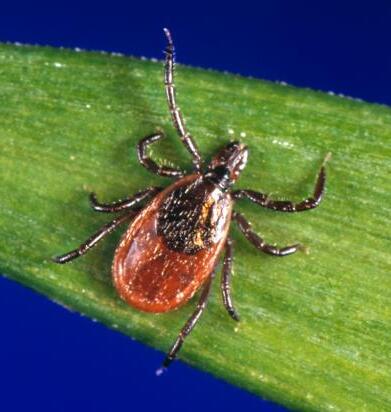Along with mosquitoes and chiggers, ticks are one of the most common campsite and wooded areas pests
Ticks are arachnid parasites that latch themselves onto the skin of mammals, birds, reptiles and amphibians to feed from their blood. As if that’s not bad enough, the worst part is that they can carry and transmit dangerous blood borne diseases, including Lyme Disease, Rocky Mountain Spotted Fever, Anaplasmosis and Babesiosis among others.
 Ixodes scapularis” by Jim Gathany – from fr.wikipedia. Licensed under Public Domain via Wikimedia Commons.
Ixodes scapularis” by Jim Gathany – from fr.wikipedia. Licensed under Public Domain via Wikimedia Commons.
Peak activity months for ticks are April to September, which happen to be the Spring and Summer months, when temperature is more pleasant and people’s outdoor activities are also at their peak. Fortunately, if you adopt appropriate measures and prepare accordingly when going camping or on a hiking trip, you can avoid them crawling up and finding a feeding spot on your body.
Avoid tick bites and any possible infection
The Centers for Disease Control (CDC) recommends the following:
- Use repellents that contain 20 to 30% DEET on exposed skin and clothing for protection that lasts up to several hours. Always follow product instructions. Parents should apply this product to their children, avoiding hands, eyes, and mouth.
- Use products that contain permethrin on clothing. Treat clothing and gear, such as boots, pants, socks and tents with products containing 0.5% permethrin; it remains protective through several washings. Pre-treated clothing is also available and may provide longer-lasting protection.
- Bathe or shower as soon as possible after coming indoors (preferably within 2 hours) to wash off and more easily find ticks that are crawling on you.
- Conduct a full-body tick check using a hand-held or full-length mirror to view all parts of your body upon return from tick-infested areas. Parents should check their children for ticks under the arms, in and around the ears, inside the belly button, behind the knees, between the legs, around the waist, and especially in their hair.
- Examine gear and pets. Ticks can ride home on clothing or pets, then attach to a person later, so carefully examine pets, coats, and day packs.
- Tumble clothes in a dryer on high heat for an hour to kill remaining ticks. (Some research suggests that shorter drying times may also be effective, particularly if the clothing is not wet.)
“Tick Waiting on Grass Blade- CentralMA-USA” by Mcvoorhis – Own work. Licensed under CC BY-SA 3.0 via Wikimedia Commons.
Additional tips are:
Use light clothing: wearing light-colored clothes can help you spot ticks before they have an opportunity to reach exposed skin.
Stick to the trails: staying on the trail will go a long way towards keeping you out of the tick’s favorite places, like tall grass and dense bush.
Don’t sit or lay on the ground: try to sit on picnic benches and camping chairs instead. Ticks can’t fly, so they will find their way onto you by direct contact with the surfaces they occupy.
Camping Tips & Tricks by Phoenix Pop Up Campers!
We want you to get the most out of your camping and outdoor experiences. With our custom made truck campers, there’s no limit to where you can go and what you can do on your next outdoor adventure.
Just choose the design from one of our three Base Models and we will adapt it to your vehicle. Each base model comes with standard features and many more are optional for you to create your perfect truck camper. And if you want something else added that is not listed, no problem, just let us know and we will do our best to accommodate it.
Contact us or fill our online form to start building your camper now! Or make an appointment to come to visit us. The world is ready to be explored. Are you?



